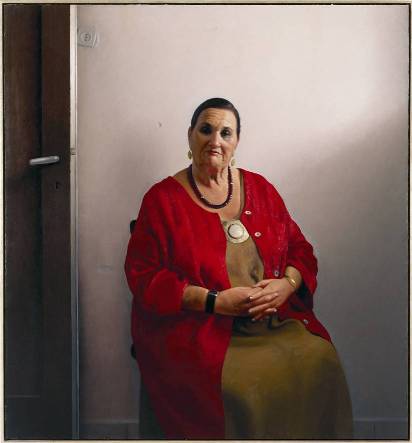
Bianca Eshel-Gershuni, jewelry designer, painter and sculptress (born Sofia, Bulgaria 1932) is holding a major exhibition of her works at Yad Lebanim, Ra’anana. A recipient of a Life Achievement Award from the Ministry of Culture and Sport, she is however an artist whose contribution to local art has never been truly appreciated. One probable reason is that her career has been overshadowed by that of her ex-husband, the painter Moshe Gershuni. But it seems even more correct to suggest that she dared to be different and paid the price. In the late 1970s when conceptual art and the use of meager materials came into fashion in Israel, her work (and that of Mordechai Ardon and many others) – rich in narrative, texture and color, and expressing emotions – was virtually banished to the sidelines.
The Ra’anana exhibition curated by Orna Fichman, bringing together examples of Eshel-Gershuni’s work from the last 30 years, makes no visual reference to her early years as a designer of jewelry in the classical tradition. Later she would create tiny wearable sculptures that mixed precious metals with cheap materials: gold, for example, with tar, feathers and plastic objects. In this respect, challenging the ‘pure’ traditions of the ancient art of metal working, and simultaneously breaking the barrier separating ‘high and ‘low’ art, Eshel-Gershuni was a true pioneer. She was among the first Israeli artists to work in that eclectic mix of styles, images and materials that characterizes the art movement known as Post-Modernism.
Most of the works on view – miniature installations in the entrance gallery, small sculptures and paintings on the first floor- are autobiographical. They relate directly to the emotional upheaval that Eshel-Gershuni experienced in 1980 following a family crisis that resulted in her husband leaving home. From that time on her art has dealt obsessively with suffering, loss and pain, and destroyed illusions as regards romantic male-female love. Not represented here, are the brooches she designed in the first years following this crisis in which needles attached to photographs of people and animals evoked voodoo rituals and attempts to employ magic to restore her life to its original happy state.
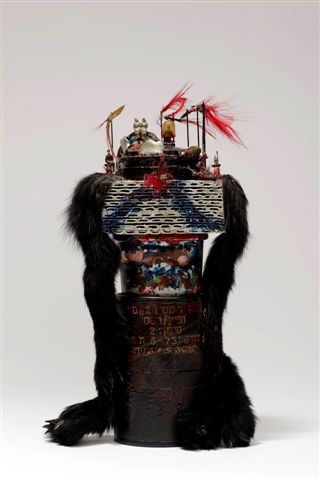
The use of kitsch, cheap and false materials, and a child-like style of painting and sculpting have become the means for putting across her highly emotional message concerning the falsity of romantic love. This attitude is not linked to liberating messages of feminism. But, daring once more to be different, her works express the idea of women as passive victims, unable to extract themselves from their domestic prisons. A typical work from the mid 1980s is a mixed media installation with the ironic title This House is Full of Love. It comprises a storied mausoleum coated in tar and draped in black fur. Two plastic dolls, a ‘loving couple’ perhaps, are set on top, fanned by red feathers.
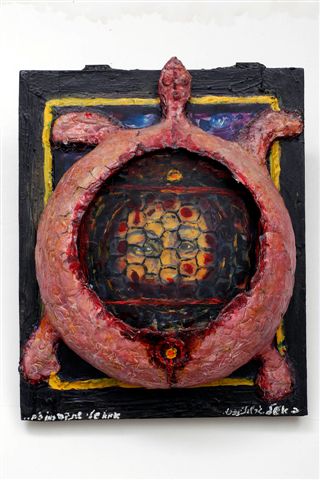
Sited nearby, and referring to the submissive role played by her mother’s generation, is the mixed media sculpture My Mother was Silent as a Turtle where a face half hidden behind barbed wire is framed by the spread body of a turtle. The turtle is an image that surfaces in many of her works (a giant stone version is sited on Raanana’s Ahuza Street, corner of Keren Hayesod, where it has become a climbing stand for local children). It seems that Eshel-Gershuni perceives the hard shell surrounding this creature’s soft body as a symbolic shelter for her own feelings and fears.
One might think that the act of creation as a way of expressing her emotions would have had a cathartic effect. But this is not so. Eshel-Gershuni’s period of mourning for a lost way of life appears to be unending. As a result, visitors to this exhibition may find this obsessive self-introspection wearisome as they move from one naïve self-portrait to the next. Yet, there are plenty of unusual features in her work to sustain one’s interest. For instance, a number of her self portraits ‘quote’ (in postmodernist style) from artworks depicting people who are victims of their circumstances.
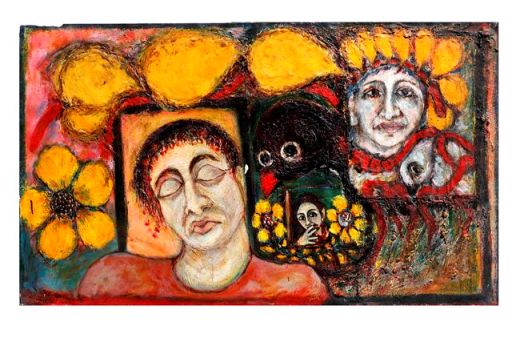
This is the case in her painting Correspondence with Piero della Francesca 11 where she introduces the face of a sleeping soldier, an image appropriated from this 15th century artist’s rendering of the resurrection of Christ. Eshel-Gershuni surrounds this figure, as well as a portrait of herself, with bright golden blooms, images that bring to mind the sunflowers of Van Gogh, a brilliant but tragic figure rejected by a public who didn’t understand his work.
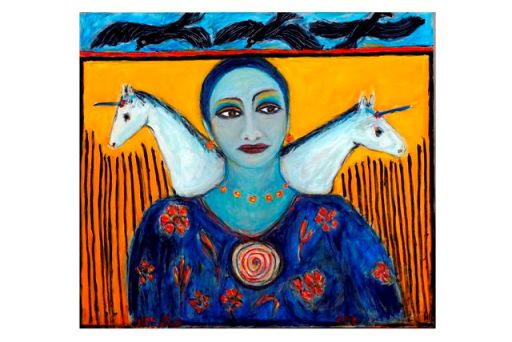
Aside from the Christian cross (symbol of suffering) which marks the neck of some self portraits, a number of positive images appear in her more recent paintings. A blue bird, for example, traditionally representing a search for happiness; and unicorns – proud, courageous animals whose horn is reputed to have magical properties. This mythical beast appears in her paintings and in the form of small colorful sculptures. However, the optimistic note struck by their presence in a self portrait from 2006 is somewhat dimmed by the sight of blackbirds hovering above her head.
A portrait from 2006-7 by her son Aram Gershuni, a well known realist painter, shows the artist as she is today. But comparing this image with the various self-portraits she has painted in the last decade( like the one illustrated above), one notes that she has progressively idealized her own features which have taken on a new serenity. In fact, the face that looks out at us from her most recent paintings is not so dissimilar to those found in the famed mosaic in the 6th century church of Sant’Apollinare Nuovo, Ravenna, depicting the Empress Theodora and her female attendants. In fact Byzantine art, of which these mosaics are part, rich in color, textures and telling a story, certainly accords to similar qualities found in Eshel-Gershuni’s work.
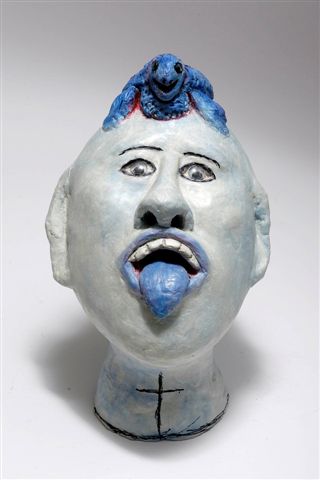
Rounding off this compelling but offbeat show, are several recent series of painted plaster heads, some with a bird or turtle attached to their crowns. Gargoyle-like, they have exaggerated facial expressions – huge, staring eyes, open mouths with lolling tongues – and most likely convey disturbed states of mind. These strange pieces do not seem to tie up with the main body of the work on exhibit. Or perhaps they do. Once again, Eshel-Gershuni dares to be different.
This exhibition at Yad Lebanim, Ra’anana is open till 30th October 2010. In addition, a small selection of recent paintings and sculpted heads by Eshel-Gershuni can also be seen at the Herzliya Museum of Art where artists who are recipients of Ministry of Culture and Sports 2009 awards are displaying recent work.
ANGELA LEVINE






Comments are closed.